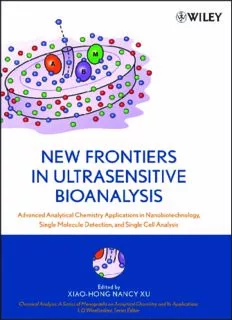
New Frontiers in Ultrasensitive Bioanalysis: Advanced Analytical Chemistry Applications in Nanobiotechnology, Single Molecule Detection, and Single Cell ... Analytical Chemistry and Its Applications) PDF
Preview New Frontiers in Ultrasensitive Bioanalysis: Advanced Analytical Chemistry Applications in Nanobiotechnology, Single Molecule Detection, and Single Cell ... Analytical Chemistry and Its Applications)
JWDD033-FM JWDD033-XU February13,2007 16:41 CharCount=0 New Frontiers in Ultrasensitive Bioanalysis i JWDD033-FM JWDD033-XU February13,2007 16:41 CharCount=0 CHEMICAL ANALYSIS ASERIESOFMONOGRAPHSONANALYTICALCHEMISTRY ANDAPPLICATIONS Editor J.D.WINEFORDNER VOLUME172 Acompletelistofthetitlesinthisseriesappearsattheendofthisvolume. ii JWDD033-FM JWDD033-XU February13,2007 16:41 CharCount=0 New Frontiers in Ultrasensitive Bioanalysis Advanced Analytical Chemistry Applications in Nanobiotechnology, Single Molecule Detection, and Single Cell Analysis Editedby XIAO-HONGNANCYXU OldDominionUniversity Wiley-Interscience A John Wiley & Sons, Inc., Publication iii JWDD033-FM JWDD033-XU February13,2007 16:41 CharCount=0 Copyright(cid:1)C 2007byJohnWiley&Sons,Inc.Allrightsreserved. PublishedbyJohnWiley&Sons,Inc.,Hoboken,NewJersey PublishedsimultaneouslyinCanada Nopartofthispublicationmaybereproduced,storedinaretrievalsystem,ortransmittedinanyformorby anymeans,electronic,mechanical,photocopying,recording,scanning,orotherwise,exceptaspermittedunder Section107or108ofthe1976UnitedStatesCopyrightAct,withouteitherthepriorwrittenpermissionofthe Publisher,orauthorizationthroughpaymentoftheappropriateper-copyfeetotheCopyrightClearanceCenter, Inc.,222RosewoodDrive,Danvers,MA01923,(978)750-8400,fax(978)750–4470,oronthewebat www.copyright.com.RequeststothePublisherforpermissionshouldbeaddressedtothePermissions Department,JohnWiley&Sons,Inc.,111RiverStreet,Hoboken,NJ07030,(201)748-6011, fax(201)748-6008,oronlineathttp://www.wiley.com/go/permission. LimitofLiability/DisclaimerofWarranty:Whilethepublisherandauthorhaveusedtheirbesteffortsin preparingthisbook,theymakenorepresentationsorwarrantieswithrespecttotheaccuracyorcompletenessof thecontentsofthisbookandspecificallydisclaimanyimpliedwarrantiesofmerchantabilityorfitnessfora particularpurpose.Nowarrantymaybecreatedorextendedbysalesrepresentativesorwrittensalesmaterials. Theadviceandstrategiescontainedhereinmaynotbesuitableforyoursituation.Youshouldconsultwitha professionalwhereappropriate.Neitherthepublishernorauthorshallbeliableforanylossofprofitoranyother commercialdamages,includingbutnotlimitedtospecial,incidental,consequential,orotherdamages. Forgeneralinformationonourotherproductsandservicesorfortechnicalsupport,pleasecontactourCustomer CareDepartmentwithintheUnitedStatesat(800)762-2974,outsidetheUnitedStatesat(317)572-3993orfax (317)572-4002. Wileyalsopublishesitsbooksinavarietyofelectronicformats.Somecontentthatappearsinprintmaynotbe availableinelectronicformat.FormoreinformationaboutWileyproducts,visitourwebsiteatwww.wiley.com LibraryofCongressCataloging-in-PublicationData: Newfrontiersinultrasensitivebioanalysis:Advancedanalyticalchemistryapplicationsinnanobiotechnology, singlemoleculedetection,andsinglecellanalysis/[editedby]Xiao-HongNancyXu. p. ; cm.–(Chemicalanalysis;v.172) Includesbibliographicalreferencesandindex. ISBN:978-0-471-74660-7(cloth) 1.Biomolecules–Analysis. 2.Nanotechnology. 3.Microchemistry. I.Xu, Xiao-HongNancy. II.Series. [DNLM:1.Chemistry,Analytical–methods. 2.CytologicalTechniques. 3.MolecularProbeTechniques. 4.Nanotechnology. QY90N5322007] QPJ19.7.N492007 572(cid:2).33–dc22 2006036935 PrintedintheUnitedStatesofAmerica 10 9 8 7 6 5 4 3 2 1 iv JWDD033-FM JWDD033-XU February13,2007 16:41 CharCount=0 CONTENTS PREFACE vii CONTRIBUTORS xi CHAPTER1. ISONEENOUGH? 1 AndrewC.Beveridge,JamesH.Jett,andRichardA.Keller CHAPTER2. DISSECTINGCELLULARACTIVITYFROMSINGLE GENESTOSINGLEmRNAs 29 XavierDarzacq,RobertH.Singer,andYaronShav-Tal CHAPTER3. PROBINGMEMBRANETRANSPORTOFSINGLELIVE CELLSUSINGSINGLE-MOLECULEDETECTIONAND SINGLENANOPARTICLEASSAY 41 Xiao-HongNancyXu,YujunSong,andPrakashNallathamby CHAPTER4. NANOPARTICLEPROBESFORULTRASENSITIVE BIOLOGICALDETECTIONANDIMAGING 71 AmitAgrawal,TusharSathe,andShumingNie CHAPTER5. TAILORINGNANOPARTICLESFORTHERECOGNITION OFBIOMACROMOLECULESURFACES 91 MrinmoyDe,RochelleR.Arvizo,AyushVerma,andVincentM.Rotello CHAPTER6. NANOSCALECHEMICALANALYSISOFINDIVIDUAL SUBCELLULARCOMPARTMENTS 119 GinaS.FioriniandDanielT.Chiu CHAPTER7. ULTRASENSITIVETIME-RESOLVEDNEAR-IR FLUORESCENCEFORMULTIPLEXEDBIOANALYSIS 141 LiZhuandStevenA.Soper CHAPTER8. ULTRASENSITIVEMICROARRAYDETECTIONOFDNA USINGENZYMATICALLYAMPLIFIEDSPRIMAGING 169 HyeJinLee,AlastairW.Wark,andRobertM.Corn CHAPTER9. ULTRASENSITIVEANALYSISOFMETALIONSAND SMALLMOLECULESINLIVINGCELLS 195 RichardB.Thompson v JWDD033-FM JWDD033-XU February13,2007 16:41 CharCount=0 vi CONTENTS CHAPTER10. ELECTROCHEMISTRYINSIDEANDOUTSIDESINGLE NERVECELLS 215 DanielJ.EvesandAndrewG.Ewing CHAPTER11. ELECTROCHEMILUMINESCENCEDETECTION INBIOANALYSIS 235 Xiao-HongNancyXuandYanbingZu CHAPTER12. SINGLE-CELLMEASUREMENTSWITHMASS SPECTROMETRY 269 EricB.Monroe,JohnC.Jurchen,StanislavS.Rubakhin, andJonathanV.Sweedler CHAPTER13. OUTLOOKSOFULTRASENSITIVEDETECTION INBIOANALYSIS 295 Xiao-HongNancyXu INDEX 301 JWDD033-FM JWDD033-XU February13,2007 16:41 CharCount=0 PREFACE This book aims to provide an overview of current exciting research topics in ultrasen- sitive bioanalysis; to provide an in-depth understanding of objectives, motivations, and future directions of the new frontiers of ultrasensitive bioanalytical research; and to in- troduce new ideas, new technologies, and new applications of ultrasensitive bioanalysis to a wide spectrum of research communities, including biological, biomedical, clinical, chemical,environmental,andmaterialsscience.Thebookstrivestoprovidesufficientfun- damentals and research background for readers to learn and apply these tools. The book is also structured in a way that can serve as a textbook or a primary reference book for anadvancedanalyticalchemistrycourseoraspecialtopiccourseforgraduateandsenior undergraduate students. I discovered the difficulty of finding effective teaching materials andsuitablereferencebooksformystudentsandcollaboratorswhileItaughtthecourseand engagedjointresearchprojectswithcolleaguesinthedepartmentofbiologicalsciencesand engineering. Ultrasensitive detection plays a vital role in advancing analytical chemistry and has been a primary driving force for the development of new analytical instrumentation and methodology. As analysis of biological samples (e.g., genomics, proteomics) and living systems(e.g.,cellularandsubcellularfunction)becomesmoredemanding,newplatforms of ultrasensitive analysis using multiplexing, single nanoparticle sensing, nano-fluidics, and single-molecule detection have emerged and have become indispensable tools to ad- vancebiological,biomedical,andbiomaterialssciencesandengineering.Furthermore,the emergingresearchfieldofnanoscienceandnanotechnologyprovidesnewpossibilitiesfor developmentofnewanalyticaltoolsandinstrumentationforbioanalysis.Forexample,the uniquepropertiesofnanoparticlesofferenormousopportunitiestodevelopnewprobesfor real-time in vivo and in vitro imaging and sensing of individual biomolecules with sub- 100-nm spatial resolution and millisecond to nanosecond time resolution. Such powerful capabilitieswillleadtothedevelopmentofnewanalyticaltechniquestoimprovedisease diagnosisandtreatment,aswellastoadvanceourfundamentalunderstandingofimportant phenomenasuchasmembranetransport,geneexpression,enzymeactivities,andintracel- lularandintercellularsignaling.Itisundeniablethatanalyticalchemistryhasevolvedtobe avitalplayerinallcutting-edgescientificresearchfields. Inthisbook,adiversegroupofanalyticalchemistsworkingintheforefrontofultrasen- stitivebioanalysissharetheirinsights,visions,andlatestresults.Thebookisstructuredto offerappreciablebackgroundonthefundamentalsandtoprovidebriefoverviewsofcurrent statusofultrasensitivebioanalysis.Moreimportantly,thisbookfocusesonshowcasingthe excitingopportunitiesofthenewfrontiersofultrasensitivebioanalysis.Thus,thisbookis muchmoreforthefuturethanforthesummaryofthepastandpresent. Thisbookincludes13chaptersandstarts,inChapter1,byaddressingthemostfunda- mentalquestionofsingle-moleculedetection(SMD):Howmanymeasurementsofasingle vii JWDD033-FM JWDD033-XU February13,2007 16:41 CharCount=0 viii PREFACE moleculearerequiredtoobtainrepresentativemolecularpropertiesofensembledistribu- tions?ItdescribestheadvantagesofSMDanditsapplicationstovirtualsortingandDNA fingerprintingofsinglegenomes.Chapter2focusesonpresentingarepresentativeappli- cation of SMD to directly observing gene expression in living cells, illustrating potential applications of SMD for better understanding of living cellular mechanism and function. Chapter3offersanoverviewofSMDusingfluorescencemicroscopyandspectroscopy,and itgivesanexampleofstudyingmembranetransportoflivingcellsusingsinglefluorophor moleculesandsingle-nanoparticleopticstoillustratethedistinguishedadvantagesofSMD andnon-photobleachingnoblemetalnanoparticlesforprobinglivingcellularmechanism andfunction.Thischapteraimstointroducethebasicdetectionschemesandexperimental configurationsofSMDandsingle-nanoparticleopticsforbioanalysisandsingle-living-cell imaging. Chapter4isdevotedtotherecentdevelopmentofmultifunctionalnanoparticleprobes, especiallyquantumdots(QDs),forultrasensitiveanalysisofbiomarkersinlivingcellsand invivoimaging,providingthelatestadvancesandfuturepossibilityofthisexcitingresearch arena. To develop nanoparticle probes for living-cell imaging, smart drug delivery, and invivodiagnosis,theprimarychallengeistorationallydesignthefunctionalnanoparticle surfaces that can specifically recognize biomolecules of interest and be biocompatible to livingsystems.Thus,Chapter5offersexamplesofthelatestadvancesindesigningsurface functionality of nanoparticles that can specifically recognize protein and DNA surfaces. Thischapterpresentsanoverviewofthisexcitingresearchtopicandprovidesawealthof experimentaldetailsandnewinsightsintothefutureresearchdirection. Miniaturizationandmultiplexinghavebecomeimportanttechnologyplatformsinultra- sensitiveanalysisofbiomoleculesandprofilingcontentsofindividuallivingcells.Chapters 6through8presentseveralinterestingresearchprojects,reportingtherecentdevelopment ofthisparticularlyexcitingresearchfield.Chapter6describesthenewplatformofusing thestate-of-the-artresearchtools,suchasalaser-basedsystemanddroplet-basedmicroflu- idics,toselectivelyextractorganellesfromlivingcellsforsubsequentanalysis.Chapter7 presents the development of near-IR fluorescent dyes, time-resolved fluorescence spec- troscopy, and multiplexing approach for DNA sequencing, offering more sensitive and informative genomic measurements. In contrast, Chapter 8 describes a new approach of directlydetermininggenomicDNAsampleswithnoneedoflabelingorPCRamplification. Inthisapproach,surfaceplasmonresonanceimaging(SPRI)isusedasalabel-freedetection means,whilenucleicacidmicroarraysserveasamultiplexingplatform,whichiscoupled withsurfaceenzymaticmethodtoamplifySPRIimagingsignal. Like proteins and DNA, metal ions and small molecules play a key role in cellular function.However,quantitativeandqualitativeanalysisofsmallmolecules,especiallymetal ions,inlivingcellsinrealtimeremainsextremelychallenging.Chapter9givesaglimpse of research activities and emerging approaches in this extremely important research area andoffersnewprospectsofthefutureresearchpossibilityanddirection. Chapter 10 describes the development and application of electrochemical methods to monitorthereleaseofneurotransmittersinrealtimeforbetterunderstandingcommunication amongindividualnervecells,demonstratingtheuniqueandpowerfuldetectioncapability ofelectrochemistry.Chapter11introduceselectrochemiluminescence(ECL)detectionfor ultrasensitive bioanalysis, describes its latest development and applications, and presents the potential challenges and exciting future research opportunities of ECL detection in ultrasensitivebioanalysis. JWDD033-FM JWDD033-XU February13,2007 16:41 CharCount=0 PREFACE ix Massspectrometryoffersanunparalleleddetectioncapabilityforidentifyingunknown analytes(e.g.,tumormarkers)andhasdemonstratedthepossibilityofprofilingthechemi- calcompositionsofindividuallivingcells.However,massspectrometrycurrentlyprovides verylimiteddetectionsensitivity.Chapter12illustratesthelatestresearchdevelopmentof usingstate-of-the-artmassspectrometryforsingle-cellanalysis,highlightsseveralrepre- sentativeexamples,andpresentstheuniqueresearchchallengesandopportunitiesinthis exciting emerging new research field. Finally, the book is concluded with Chapter 13: it summarizescurrentcutting-edgeultrasensitivedetectionmeansinbioanalysis,alongwith theiruniquefeaturesandpotentialapplications.Thisfinalchapteralsooffersabriefoutlook onultrasensitivebioanalysisintermsofemergingtechnologiesandmethodologies,along withnewchallengesandopportunities. I hope that this book will serve as a valuable tool for beginning and well-established scientists, especially graduate students and the researchers who consider learning about andusingultrasensitivedetectiontools.Ihaveselectedoneexampleofparticulardetection techniquesandresearchapproachestoillustratetheconcepts,ideas,experimentaldesign, andpotentialapplicationsofresearchfield,ratherthanprovidingacomprehensivereview of an entire research field. It is hoped that through these selected examples, the readers willfeelthevibrantandexcitementofentireresearchfieldandwillpursuesomanyother distinguishedresearchworksthatareunabletobeincludedinthisbook.Thus,Ihopethat Iwillhavetheforgivenessandunderstandingofmycolleagueswhoseresearchworkhas notbeenpresentedhere. I am very grateful to all contributors for their enthusiastic support and for taking pre- cious time from their demanding busy schedule to prepare the chapters. I would like to acknowledge each and every one of them for their generous effort and inputs. I wish to extendmygratitudetoJamesWinefordneratUniversityofFloridaforhispersistentinvi- tations over years, as well as to Heather Bergman at Wiley-Interscience for her valuable assistance. It has been a very pleasant and valuable experience for me to work on this book. I gainedthefirst-handappreciationandbetterunderstandingoftheeffort,time,energy,and persistencethatareessentialforaneditorofabook.Withanalreadysaturateddailyschedule ofyoungacademics,Ihadtodevoteallmyweekendsandholidaysthispastyeartoworking on this book in the hope that it would reach readers in time to meet the demands of this veryrapidlyexpandingresearcharena.Iwillbeextremelydelightfulifreaders,especially studentsandnewinvestigators,findthatthebookstimulatestheirfascinationinultrasenstive bioanalysisandhelpsthemtosteertowardnewresearchdirectionsthatultimatelyleadto newscientificdiscoveries. Despitemybesteffort,IammindfulthatIcouldhavedonemoreineditingthisbook. Therefore,Iameagertoheartheconstructivecommentsandsuggestionsofmycolleagues and readers. I am determined to continue to engage in vigorous research and teaching activities in this thriving research field, and I plan to prepare follow-up volumes in the comingyears. It is fitting to take this opportunity to acknowledge several funding agencies for their generoussupportofmyresearchprogram:NIH(R21RR15057;R01GM0764401),NSF (BES 0507036; DMR 0420304), DoD-MURI (AFOSR #F49620-02-1-0320), DOE (DE- FG02-03ER63646), and Old Dominion University. This financial support allows me to activelyparticipateinthisexcitingcutting-edgeresearchfield,acquirethefirst-handresearch experience, widely interact with colleagues in the field, closely follow the advance of
Description: